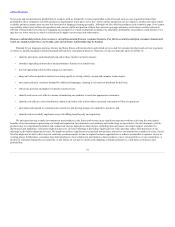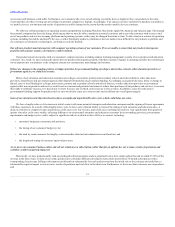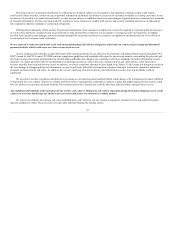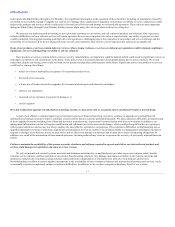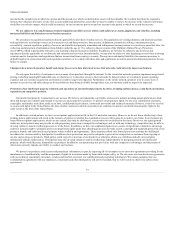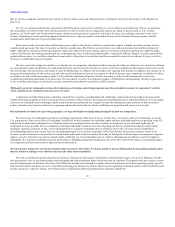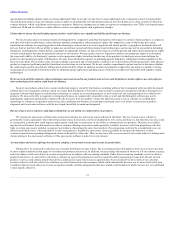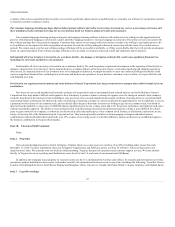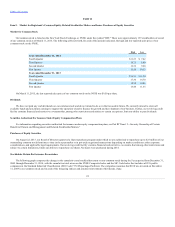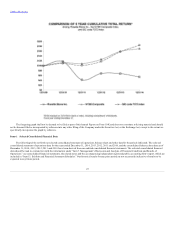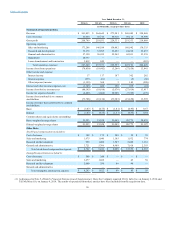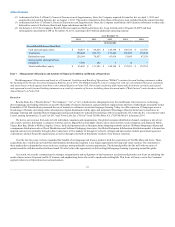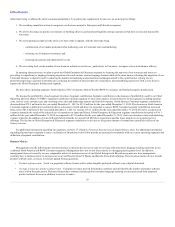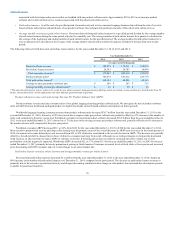Rosetta Stone 2014 Annual Report Download - page 21
Download and view the complete annual report
Please find page 21 of the 2014 Rosetta Stone annual report below. You can navigate through the pages in the report by either clicking on the pages listed below, or by using the keyword search tool below to find specific information within the annual report.
Table of Contents
income for the jurisdictions in which we operate and the period over which our deferred tax assets will be realizable. We could in the future be required to
increase the valuation allowance to take into account additional deferred tax assets that we may be unable to realize. An increase in the valuation allowance
would have an adverse impact, which could be material, on our income tax provision and net income in the period in which we record the increase.
We are subject to U.S. and foreign government regulation of online services which could subject us to claims, judgments, and remedies, including
monetary liabilities and limitations on our business practices.
We are subject to regulations and laws directly applicable to providers of online services. The application of existing domestic and international laws
and regulations to us relating to issues such as user privacy and data protection, data security, defamation, promotions, billing, consumer protection,
accessibility, content regulation, quality of services, and intellectual property ownership and infringement in many instances is unclear or unsettled. Also, the
collection and protection of information from children under the age of 13 is subject to the provisions of the Children's Online Privacy Protection
Act (COPPA), which is particularly relevant to our learning solutions focused on children. In addition, we will also be subject to any new laws and
regulations directly applicable to our domestic and international activities. Internationally, we may also be subject to laws regulating our activities in foreign
countries and to foreign laws and regulations that are inconsistent from country to country. We may incur substantial liabilities for expenses necessary to
defend litigation in connection with such regulations and laws or to comply with these laws and regulations, as well as potential substantial penalties for any
failure to comply.
Changes in how network operators handle and charge for access to data that travel across their networks could adversely impact our business.
We rely upon the ability of customers to access many of our products through the internet. To the extent that network operators implement usage based
pricing, including meaningful bandwidth caps, or otherwise try to monetize access to their networks by data providers, we could incur greater operating
expenses and our customer acquisition and retention could be negatively impacted. Furthermore, to the extent network operators were to create tiers of
internet access service and either charge us for or prohibit us from being available through these tiers, our business could be negatively impacted.
Protection of our intellectual property is limited, and any misuse of our intellectual property by others, including software piracy, could harm our business,
reputation and competitive position.
Our intellectual property is important to our success. We believe our trademarks, copyrights, trade secrets, patents, pending patent applications, trade
dress and designs are valuable and integral to our success and competitive position. To protect our proprietary rights, we rely on a combination of patents,
copyrights, trademarks, trade dress, trade secret laws, confidentiality procedures, contractual provisions and technical measures. However, even if we are able
to secure such rights in the United States, the laws of other countries in which our products are sold may not protect our intellectual property rights to the
same extent as the laws of the United States.
In addition to issued patents, we have several patent applications on file in the U.S. and other countries. However, we do not know whether any of our
pending patent applications will result in the issuance of patents or whether the examination process will require us to narrow our claims. Even if patents are
issued from our patent applications, which are not certain, they may be challenged, circumvented or invalidated in the future. Moreover, the rights granted
under any issued patents may not provide us with proprietary protection or competitive advantages, and, as with any technology, competitors may be able to
develop similar or superior technologies now or in the future. In addition, we have not emphasized patents as a source of significant competitive advantage
and have instead sought to primarily protect our proprietary rights under laws affording protection for trade secrets, copyright and trademark protection of our
products, brands, and other intellectual property where available and appropriate. These measures afford only limited protection and may be challenged,
invalidated or circumvented by third parties. In addition, these protections may not be adequate to prevent our competitors or customers from copying or
reverse-engineering our products. Third parties could copy all or portions of our products or otherwise obtain, use, distribute and sell our proprietary
information without authorization. Third parties may also develop similar or superior technology independently by designing around our intellectual
property, which would decrease demand for our products. In addition, our patents may not provide us with any competitive advantages and the patents of
others may seriously impede our ability to conduct our business.
We protect our products, trade secrets and proprietary information, in part, by requiring all of our employees to enter into agreements providing for the
maintenance of confidentiality and the assignment of rights to inventions made by them while employed by us. We also enter into non-disclosure agreements
with our technical consultants, customers, vendors and resellers to protect our confidential and proprietary information. We cannot guarantee that our
confidentiality agreements with our employees, consultants and other third parties will not be breached, that we will be able to effectively enforce these
agreements,
19


